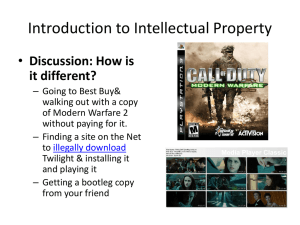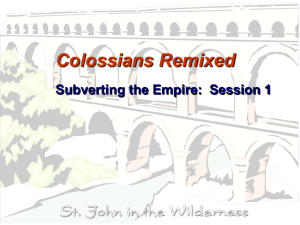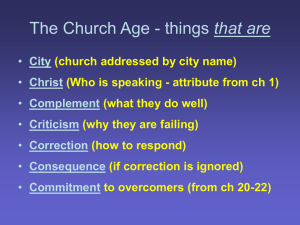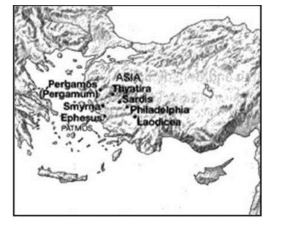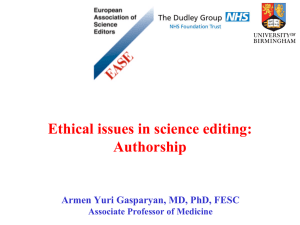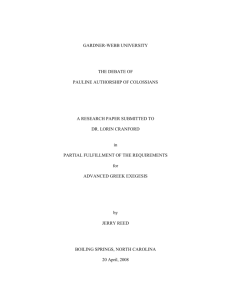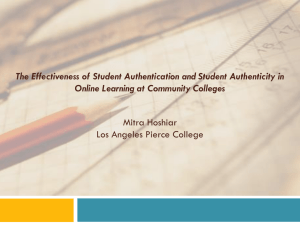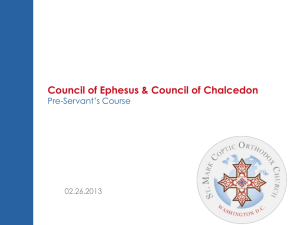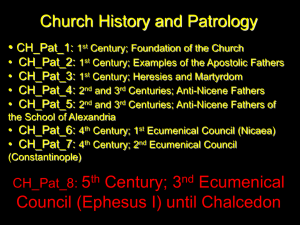The Book of Colossians – part 1, Dr. Alan Bandy (PowerPoint)
advertisement
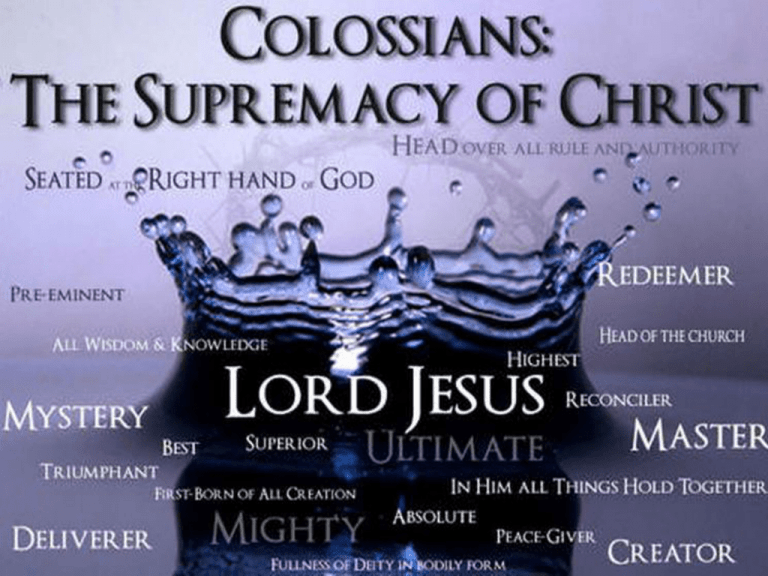
COLOSSIANS KEY FACTS Author: Paul Date: Around 60 Provenance: Imprisonment in Rome/*Ephesus(?) Destination: Colossae Occasion: False teaching Purpose: Combat false teaching with the supremacy and sufficiency of Christ Theme: Christ is complete in every way and thus believers are complete in Christ Key Verses: 2:6–10 INTRODUCTION Paul’s letter to the Colossians is perhaps the most Christocentric letter in the NT. Colossians offers a strong corrective to the false teachings in the Lycus Valley that minimized the importance of the person and work of Christ. The letter also demonstrates that gratitude to Christ for the great salvation he provided serves as a principal motivation for the Christian life. Every chapter of Colossians mentions thanksgiving. HISTORY Authorship Date Provenance Destination Occasion Purpose Authorship: Authenticity The letter opens with a claim that Paul was the author (1:1) and contains two further expressions of personal identification in 1:23 (“I, Paul”) and 4:18 (“I, Paul, write this greeting in my own hand”). The letter also refers to Timothy, Epaphras, John Mark, and Barnabas, whom were companions of Paul as document in the book of Acts. Authorship: Authenticity Colossians retains its place among the undisputed epistles of Paul. Paul identifies himself as the author (1:1; 4:18), and the Church Fathers endorsed Pauline authorship with no reservations (Irenaeus, Adv Haer 3.14.1; Tertullian, De Praescr Haer 7; Clement of Alexandria, Strom 1.1; cf. Justin, Dialogue 85.2; 138.2). Not until recently have scholars begun to question the authenticity of Pauline authorship based on vocabulary, style, and theology. Authorship: Authenticity Three recurring factors dominate the case for inauthenticity: (1) Language and literary style Colossians contains 34 hapax legomena, words that do not appear elsewhere in the NT. The letter also contains 28 words that do not appear in Paul’s other letters. (2) Theology Some scholars object to additions to and departures from the undisputed letters in the areas of Christology, eschatology, and ecclesiology. Others focus on the absence of key Pauline theological terms such as law, justification, salvation, and others. (3) The close relationship of Colossians to Ephesians Concerning the close relationship between Colossians and Ephesians, some scholars assert that one writer would never produce two such similar letters. Authorship: Authenticity Scholars who favor Pauline authorship typically reply with four points. First, some arguments against authenticity reflect a strong bias against the authenticity of the letter and are better viewed as positive evidence for Paul’s authorship of Colossians. Second, those who reject Paul’s authorship are hard pressed to provide a rationale for the personal references in the letter and the choice of this particular church. Third, the theological differences between Colossians and the undisputed Pauline letters have been exaggerated. Fourth, the arguments from language and style are unpersuasive. Authorship: Authenticity Paul’s authorship primarily rests on the strength of four pillars: (1) The letter’s own claim to authenticity. (2) The unbroken tradition throughout church history. (3) The close connections between Colossians and Philemon, a letter which almost all accept as authentic. (4) The questions surrounding the practice and acceptance of pseudonymity. Date If written by Paul from Caesarea or Ephesus, then the letter has a date some time in the 50s. If written by Paul from Rome, then one must place the composition of the letter at around 58–60. Many scholars date the first Roman imprisonment in the early 60s. Provenance Debate about the provenance of the letter began in ancient locating the origin as either Ephesus or Rome. The presence of Luke appears to support a Roman hypothesis, because Acts places Luke with Paul in Rome, while Paul’s Ephesian ministry is not one of the “we” passages in Acts. Acts 27:2 also indicates that Aristarchus accompanied Paul to Italy and most likely all the way to Rome Although good arguments can be made for Ephesus, the balance of the evidence favors a Roman provenance. Destination The destination is not in question. The city was a mixed population of Phrygians, Romans involved in political affairs, and Jews of the Diaspora. The greatness of the city was due to its location in the Lycus valley (modern-day Turkey) on the main east-west road from Ephesus to the east. The lush Lycus valley provided plenty of food for grazing sheep, and the wool from the sheep supported a large clothing industry. Two neighboring towns, Laodicea and Hierapolis, eclipsed Colossae in importance by the time of Paul. Act 19:26 "And you see and hear how this fellow Paul has convinced and led astray large numbers of people here in Ephesus and in practically the whole province of Asia. He says that gods made by human hands are no gods at all." Colossae: Epaphras, Philemon, Onesimus Hierapolis Laodicea Col 4:7-16 "Tychicus will tell you all the news about me. He is a dear brother, a faithful minister and fellow servant in the Lord. 8 I am sending him to you for the express purpose that you may know about our circumstances and that he may encourage your hearts. 9 He is coming with Onesimus, our faithful and dear brother, who is one of you. They will tell you everything that is happening here. 10 My fellow prisoner Aristarchus sends you his greetings, as does Mark, the cousin of Barnabas. (You have received instructions about him; if he comes to you, welcome him.) 11 Jesus, who is called Justus, also sends greetings. These are the only Jews among my co-workers for the kingdom of God, and they have proved a comfort to me. 12 Epaphras, who is one of you and a servant of Christ Jesus, sends greetings. He is always wrestling in prayer for you, that you may stand firm in all the will of God, mature and fully assured. 13 I vouch for him that he is working hard for you and for those at Laodicea and Hierapolis. 14 Our dear friend Luke, 15 Give my greetings to the brothers and sisters at Laodicea, and to Nympha and the church in her house. 16 After this letter has been read to you, see that it is also read in the church of the Laodiceans and that you in turn read the letter from Laodicea." the doctor, and Demas send greetings. Laodicea and Hierapolis Evangelized During Paul’s Stay in Ephesus and Laodicea is one of the Seven Churches of Revelation Occasion Paul wrote to counter the “Colossian Heresy” or some teachings accepted in the Church that was an affront to the gospel of Jesus Christ. The high Christology presented in the epistle (1:15-19) indicates that this false teaching devalued Jesus. The teaching was identified as a “philosophy” (2:8) drawn from some Hellenistic traditions indicated by the references to “the fullness” (1:19), the “elemental forces” (stoicheia, 2:8, 20), “wisdom” (2:3, 23), and “ascetic practices” (2:23). It is more difficult to detect certain catchwords of this philosophy in Colossians, but a few phrases stand out: “the entire fullness” (2:9); “insisting on ascetic practices and the worship of angels” (2:18); “claiming access to a visionary realm” (2:18); “Don’t handle, don’t taste, don’t touch” (2:21); and “ascetic practices, humility, and severe treatment of the body” (2:23). In addition, this philosophy contained a number of aspects drawn from the Jewish milieu like circumcision (2:11; 3:11), “human tradition” (2:8), Sabbath observance, food regulations, Jewish festival participation (2:16), the “worship of angels” together with “access to a visionary realm” (2:18) and other harsh human regulations (2:2123). Occasion Scholars have studied these strands and attempted to locate a group or movement in the first century that matches all the criteria. Paul’s opponents were notoriously difficult to identify with precision. Four main proposals include: (1) Essene Judaism and Gnosticism (2) Hellenism (3) Judaism (1) (Syncretistic) Paganism Mystery Cults and Apotropic Magic Chtonian Greek Triple-Earth-Goddess, Tepresenting the Maiden, the Mother and the Crone all aspects of the Mother Goddess. Her origins are in Asia Minor, where she was worshipped as the primary mother goddess. Later transformed into a Goddess of Magic, Moon and Night, Ruler of Ghosts, Underworld-goddess, Protectress and Patroness of Magicians, Fortunetellers and Witches. Purpose One can easily see that Colossians serves as a Christ-centered correction to the Colossian errorists, whether one knows all the details of their errors or not. We can still understand the overall response regardless of background.

